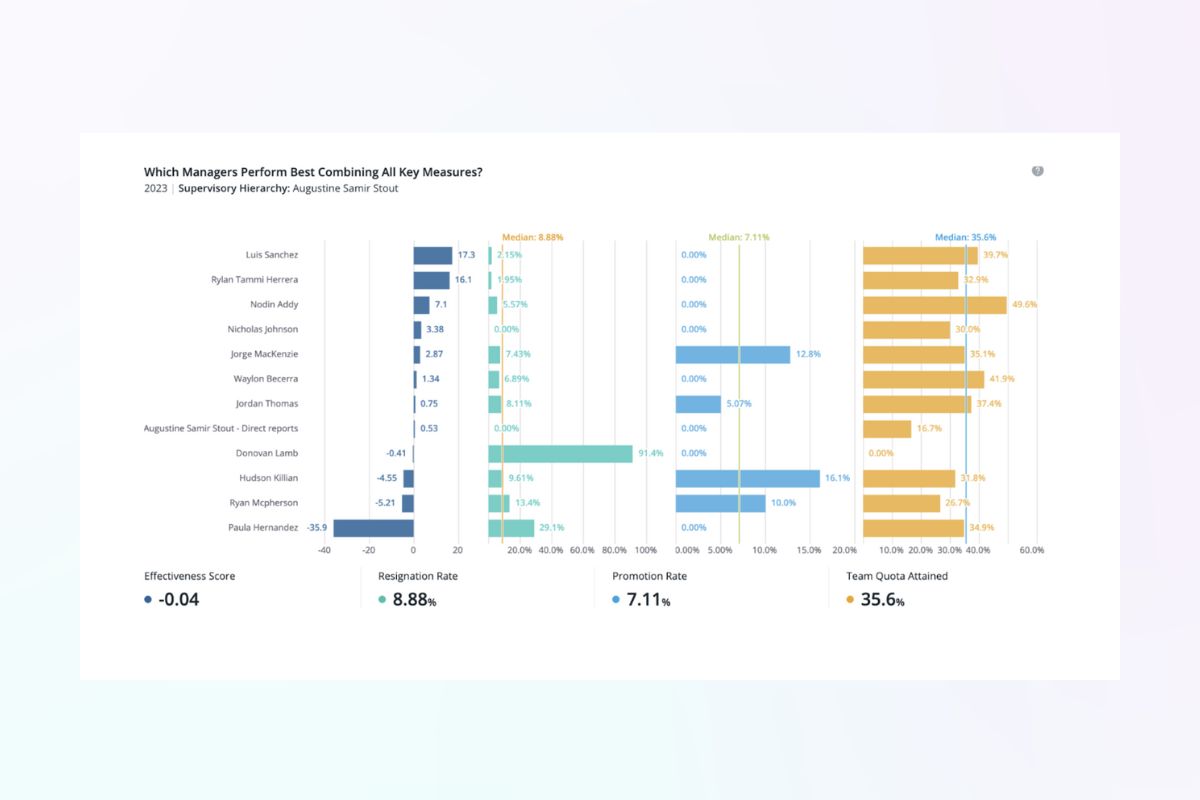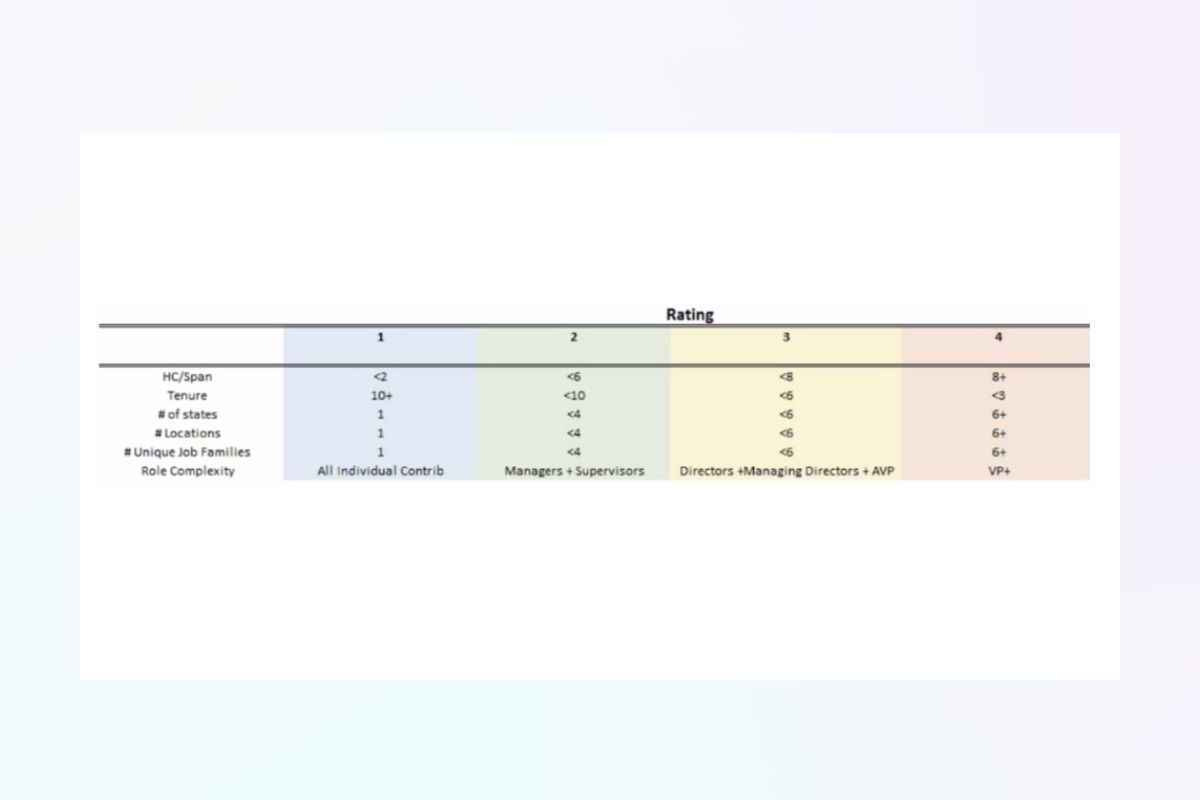Ask Visier: How does Manager Effectiveness help shape team performance?
An expert shares why manager effectiveness is critical to organizational success and strategies you can use to build a culture that prioritizes leadership excellence and data-driven decision-making.

Manager effectiveness has become a critical focus for organizations seeking to drive innovation, retain talent, and maintain operational excellence. Research consistently highlights the significant impact that effective managers alongside people analytics have on employees and overall business success.
Here’s why manager effectiveness matters and how organizations can measure and improve it.
Why is being a manager so hard?
According to The Josh Bersin Company, effective managers are 7 times more likely to innovate, 6.7 times more agile, and 7.3 times more likely to engage and retain employees.
However, the impact of ineffective managers can be heart-stopping:
Ineffective managers cost U.S. companies an estimated $360 billion annually due to stress-related health costs, productivity loss, and employee turnover. And one-third of employees would feel relief if their manager resigned.
These statistics show that effective management isn’t just a "nice-to-have". It’s a business imperative.
However, being a manager has never been more challenging.
We went from managing ‘employees at work’ to managing ‘humans at home’. The role of the people manager has never been more complex, and at the same time, the demands on productivity are even greater. According to Perceptyx, more than 40% of managers feel squeezed between upper management and their teams, contributing to overwhelming stress.

Getting started with building a culture of manager effectiveness
Creating a culture that prioritizes effective management is a long-term investment that pays off in higher employee engagement, productivity, and retention, not to mention manager well-being.
Organizations can start by:
Defining manager success: Align manager effectiveness metrics with organizational goals.
Providing ongoing development: Ensure managers have access to continuous learning opportunities.
Tracking progress: Use data-driven tools to monitor manager effectiveness and make adjustments as needed.
A framework for measuring manager effectiveness
Measuring manager effectiveness can help identify which managers contribute positively to organizational goals and which may need development.
While it can be difficult to quantify, companies like Visier offer frameworks to assess manager performance through a data-driven approach. Here’s a summary of the two-step method:
The Manager Effectiveness Index (MEI)
The Manager Effectiveness Index is an aggregate score based on factors like:
Resignation rate: How often are employees under this manager leaving the company?
Promotion rate: Are team members advancing in their careers?
Team quota attainment: Is the manager's team meeting or exceeding performance targets?
The MEI helps organizations create a standardized score by which managers can be assessed. For example, lower resignation rates and higher promotion rates may signal effective management. You can adjust this index to reflect organizational priorities.

Sample Visier data illustrating a Manager Effectiveness Index
2. Customizable metrics for your organization
Every organization is unique. Start with the data you have and expand metrics as needed. Inputs to a manager effectiveness score might include:
Workforce productivity: Track team output where possible (e.g. sales figures, project completion rates).
Engagement scores: Measure employee satisfaction and engagement under each manager.
High performer retention: Keep an eye on the turnover of top talent.
Access to tools and resources: Evaluate if the manager provides what the team needs to succeed.
Diversity and inclusion: Consider the diversity of the manager’s team and its impact on innovation and problem-solving.

Advanced methods for assessing manager effectiveness and effort
Some organizations go beyond traditional metrics by assessing manager effort, which measures the complexity of managing a team. Factors influencing manager efforts include:
Span of control: How many direct reports does the manager have?
Team diversity: How varied are the job roles and locations of the team members?
Role complexity: Is the team composed of a mix of individual contributors, managers, and senior leaders?
Understanding the nuances of a manager’s role can provide a clearer picture of the effort required to manage the team effectively. The following illustrates a framework for thinking about this.

Illustration of a Manager Effort Index where attributes are weighted based on added complexity
Strategies for measuring manager effectiveness and overcoming barriers
While developing a Manager Effectiveness Index can provide critical insights, certain challenges need to be addressed:
In terms of data availability, not all teams or managers have data that lend themselves to clear productivity metrics. Start small by focusing on areas where data is readily available and build from there.
When it comes to the span of control, managers with small teams can show skewed data, especially if a high performer leaves. Ensure that spans of control are reasonable for fair assessments.
As for how complex roles are, managers who lead teams with varied roles and levels of complexity may require different metrics to assess their effectiveness fairly.
How to improve manager effectiveness
Improving manager effectiveness requires a holistic approach that addresses both input (what enables managers to succeed) and output (the impact managers have on the business). Below are practical strategies for organizations:
1. Manager training and development
Invest in leadership development programs that provide managers with the skills to lead effectively. Training should focus on emotional intelligence, feedback delivery, coaching, and adaptability.
2. Regular feedback and 360-degree reviews
Use 360-degree feedback tools to get input from not only direct reports but also peers and senior leaders. This approach gives managers a full picture of their performance and areas for improvement.
3. Access to resources
Ensure that managers have access to the tools, information, and support needed to lead their teams effectively. This includes everything from technology to mentoring and peer networks.
4. Measure and reward success
Recognize and reward managers who contribute to the success of the business, not just in terms of output, but also for maintaining high engagement and retention levels on their teams.
5. Balancing span of control
Avoid overburdening managers by ensuring their teams are appropriately sized. Consider the complexity of the roles they oversee and adjust spans of control to a manageable level.
Next steps
Manager effectiveness matters because managers are critical to organizational success. By measuring and improving how managers lead, companies can reduce turnover, boost employee satisfaction, and increase innovation and agility.
Tools like Visier's Manager Effectiveness Index provide a structured way to assess and enhance managerial impact. With the right focus on development, feedback, and data-driven assessment, organizations can foster a culture of leadership excellence that drives long-term growth and success.



